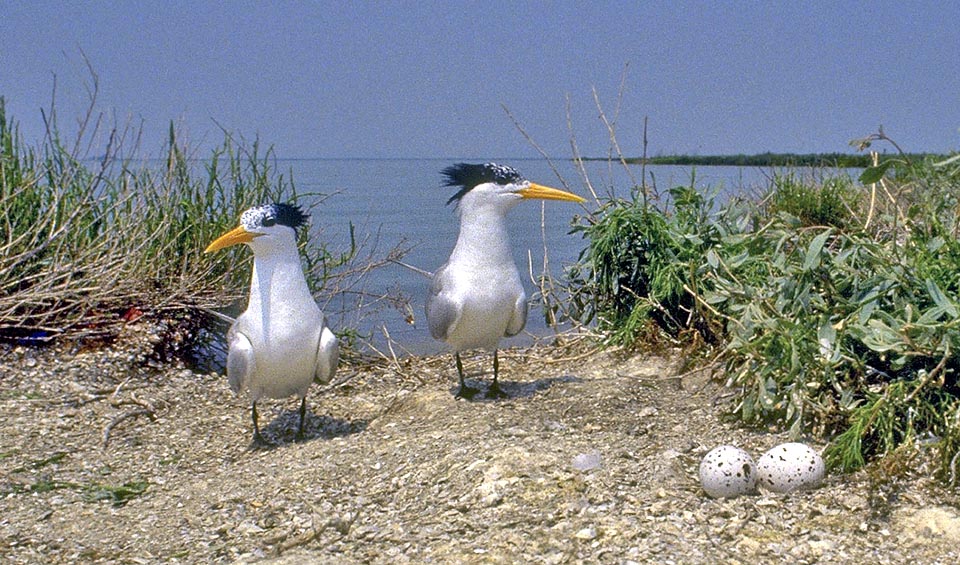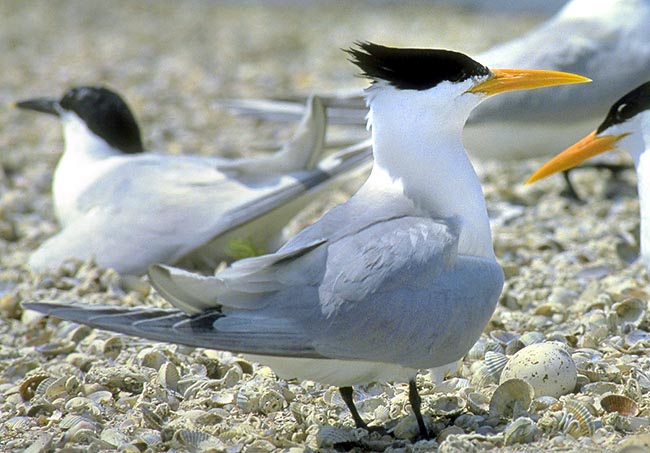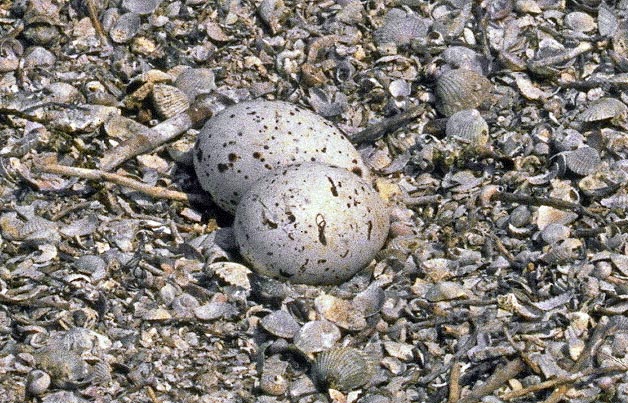Family : Laridae

Text © Pierandrea Brichetti – Ornithologist

English translation by Mario Beltramini

Pair with spawned eggs in a Valli di Comacchio islet, in a zone covered by bivalves debris © Pierandrea Brichetti

Pair nesting in a colony of Sandwich terns in the Valli di Comacchio © Pierandrea Brichetti
Polytypic species almost exclusively marine, with reproductive area limited to two quite separated districts, one including the Red Sea, Persian Gulf and Mediterranean, the other one present along the south-eastern New Guinea and northern Australia, with three recognized subspecies and a global population estimated in about 180.000-210.000 individuals.
The Mediterranean population, ascribed to the subspecies T. b. emigrata, seems concentrated in 3-4 small islands off Libya, with a consistency just above the 2000 pairs, whilst the European one, during the last 30 years, has not exceeded, yearly, the 5 nesting pairs, with cases or nesting attempts of pure or mixed pairs in France (Camargue, Banc d’Arguin), Spain (Ebro Delta, Valencia Albufera lagoon), Greece (Evros Delta) and United Kingdom (Farne Islands); in Italy, the first case of reproduction has been discovered in 1985 in the Valli di Comacchio and yearly reconfirmed at least till 2002, with absence in 1999, when the nesting has been ascertained in the Venetian Lagoon; the number of the reproducers has never, however, exceeded the 1-2 pairs per year.
Habitat-Ecology
It nests on sandy or coralline substrata, with very low, scarce or absent, vegetation, along the coasts of warm seas but preferably on small islands; also during the other seasons it keeps distinctly marine habits, accidentally getting in the hinterland.

The eggs background is whitish whilst this is very variable in the Sandwich tern © Pierandrea Brichetti
It is partial migrant in most of its tropical and sub-tropical home range, with movements and hibernation areas still not well known.
The Mediterranean population seems to hibernate mainly along the coasts of western Africa (especially in the Guinea Gulf), reached by following the northern coasts of North Africa, crossing the Strait of Gibraltar, and then going ahead along the Atlantic ones, whilst the individuals nesting in eastern Libya colonies might migrate towards the Red Sea; a limited number of individuals should remain to spend the winter in the low Mediterranean along the North-African coasts. The migration movements take place between the end of July and the beginning of November and between March and early June. Some errant individual has accidentally reached the inner zones of central Europe (Germany, Austria, Switzerland, France and Slovenia).
Morpho-physiology
It is a medium-sized tern, extremely similar per size and structure to the more common Sandwich tern (Thalasseus sandvicensis), but the wings which are slightly narrower and the yellow-orange bill just bigger at the base and of different colours characters partly appreciable only by direct confrontation.
The pullet is recognizable by the whitish body and the yellow-greenish bill © Pierandrea Brichetti
The vocalizations resemble to those of the Sandwich tern, but are slightly less strident and acute.
Ethology-Reproductive Biology
Markedly gregarious, it forms repro- ductive colonies even much consistent, associating willingly to congeneric species of similar or greater size; in the Mediterranean it is often sighted aggregated to the Sandwich tern.
The pair bond is of monogamous type. A rudimentary nest is built between May-June on the ground and the female spawns there 1-2 eggs, to whose incubation take care both sexes for 21-26 days; the young, initially gathered in “kindergartens”, become apt for flying after 30-35 days, but are fed by the adults for various more months.
The diet is based mostly on small marine fishes and partly on invertebrates, especially crustaceans. For catching the preys, it often dives perpendicularly from above, but at times it utilizes also the technique of the Common tern (Sterna hirundo), by preceding the dives with a not particularly frenetic “holy spirit”.
→ For general information about the Charadriiformes please click here.
→ To appreciate the biodiversity within the CHARADRIIFORMES please click here.
